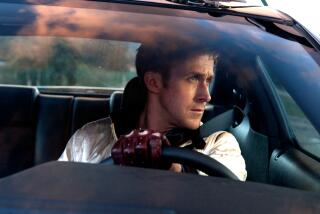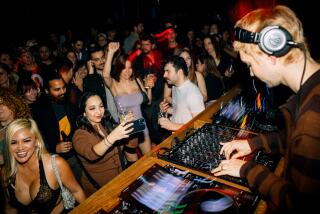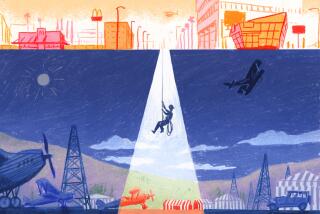Q&A: ‘I’ve been flashed. I’ve been mooned’: The Hollywood Boulevard adventures of artist Tim Youd, who is spending July retyping John Rechy’s ‘Numbers’ at Griffith Park

For roughly four years, Los Angeles artist Tim Youd has been retyping great English-language novels one by one. Youd retypes John Rechy’s novel “City of Night” as part of a performance at LACE in Hollywood.
Most nights on Hollywood Boulevard, the urban soundtrack blends together the dull thump of music spilling out from bars, the raucous laughs of club kids and the plaintive mumbles of panhandlers in need of a buck. For much of June, there was also the sound of a typewriter, its clicks and clacks echoing amid the bong shops and T-shirt emporiums of one of America’s most famous tourist strips.
The sound, amplified by a microphone, was part of a performance by Los Angeles artist Tim Youd, who for roughly the last four years has been retyping great English-language novels one by one in different locations.
Youd functions as a sort of living exhibition. Most nights during the second half of June he was seen through the street-front window of Hollywood Boulevard’s Los Angeles Contemporary Exhibitions, retyping John Rechy’s infamous hustler novel “City of Night” on an old Underwood Model S.
This week, he begins retyping another Rechy novel: “Numbers,” about a protagonist named Johnny Rio, who cruises Griffith Park in search of anonymous sexual encounters as he comes to terms with his past and his sexuality.
See the most-read stories in Entertainment this hour »
Youd has long made drawings and paintings, many of them inspired by words and literature. But four years ago, inspired by books — their literal shape and the methods in which they are produced — as well as a meaningful pilgrimage to Ernest Hemingway’s house in Key West, he began to tackle the idea of the book in a series of performances titled the “100 Novels Project.”
For these, Youd retypes entire novels onto one double-layer sheet of paper (the second layer to catch seeping ink) with the same model typewriter used by the writer of the novel. (This means the Underwood for Rechy, a Royal Quiet Deluxe for Charles Bukowski and an Underwood Universal for William Faulkner.) Each of these performances is held in a location that is somehow connected to the book.
In the case of Faulkner, Youd traveled to the author’s home in Mississippi. He typed Bukowski’s “Post Office” at the U.S. Post Office Terminal Annex in downtown Los Angeles, where Bukowski worked for 14 years. Hollywood Boulevard is key to Rechy’s “City of Night,” which opens with the line, “Later I would think of America as one vast City of Night, stretching gaudily from Times Square to Hollywood Boulevard ….”
For “Numbers,” he will materialize daily at the Fern Dell Drive entrance to Griffith Park, where starting Wednesday he will retype the novel at a portable table. “That’s the entrance that led to the area where a lot of the cruising went on,” says Youd. “And some people say that it even goes on today.”
I’ve seen a pretty bad fistfight. I’ve had people dancing for me in the windows — a little twerking.
— Tim Youd, artist
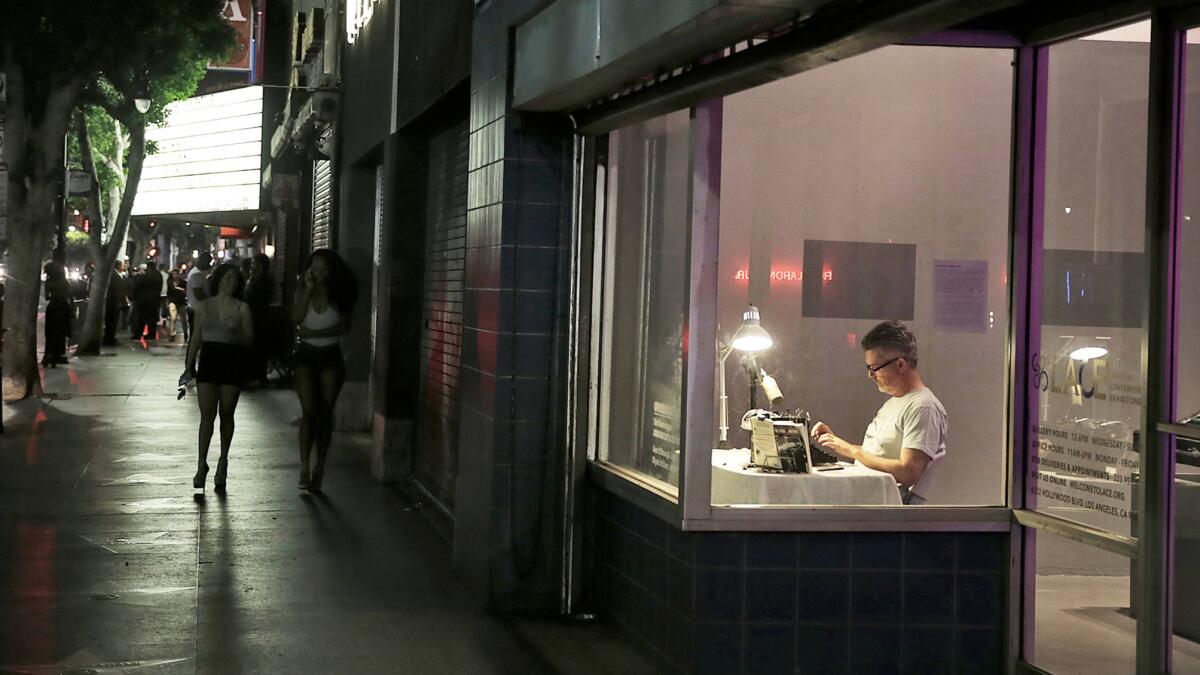
Youd creates related works as evidence of his performances: Sculptures of typewriters crafted from cardboard, abstract geometric paintings made from the spent typewriter ribbons he accumulates and mounted works that feature the inky, blackened, shredded sheets of paper employed in the typing process.
In this lightly edited conversation, Youd takes some time away from the keys to discuss the origins of his project, what he’s learned about reading and literature in the process, and the weirdest stuff he’s seen in Hollywood during his solitary overnights at LACE.
You have now spent countless nights on Hollywood Boulevard, retyping Rechy’s novel. What have you seen?
I’ve been flashed. I’ve been mooned. I’ve seen a pretty bad fistfight. I’ve had people dancing for me in the windows — a little twerking. I see a lot of club-goers because I’m right next to a couple of clubs. I see tourists. Earlier in the evening, I get more families. Every now and again I’ll get a family at 2 in the morning with kids — which is interesting to me. And of course I get people who are intoxicated or strung out or mentally disturbed. You get the city in all of its glory and its pain.
While it can have a carnivalesque atmosphere, there has also been a good deal of real engagement in terms of people stopping to try to understand what I’m doing. I have regulars who know me and give me the thumbs-up when they walk by.
How did the idea come about to retype novels as a work of performance?
There were a couple of things that were at play. Reading for me, even when I was not an artist, that was my default activity — whether I was happy and looking for enrichment or unhappy, looking for escape. One day I realized, looking at a book on a formal level, that a book is a rectangle of black text within a rectangle of a white page. So I thought, “How could I squash the book? Could you squeeze it until you get all of the words of the book onto one page?” At first I thought, “Should I hand-write it?” Then I thought, “A book is typeset, so I’ll use a typewriter.”

I’d also read somewhere that Hunter S. Thompson, when he decided to be a writer, he typed [F. Scott Fitzgerald’s] “The Great Gatsby” and [Hemingway’s] “The Sun Also Rises” out on a typewriter. And so I went and bought an IBM Selectric and I did Hunter S. Thompson’s “Fear and Loathing in Las Vegas.” I proceeded to put all of the words on one page, with a second page behind it.
I did one and I thought, “This is interesting. I’m going to explore it a bit more.” As it evolved, I realized that I wanted to do more than just a few — it could be an idiosyncratic literary pilgrimage, in places that relate to the writer and the novel’s life. For me, it was about how I can become a better reader as I walk through this thing.
What led you to choose Rechy’s book for the project?
A couple of years ago, Sarah Russin, who runs LACE, came to my studio and she asked if I would propose something. And I thought, “Hollywood Boulevard, that could be interesting.” I had become aware of “City of Night” many years ago — probably through knowing about how it inspired the Jim Morrison song “L.A. Woman.” I picked it up and really started to read it.
It’s a great novel. It’s fundamentally so honest. It’s such a revealing, unflinching portrait of this person who is putting himself out there in a way that is so unguarded. That’s hard to find. And it’s hard to find that kind of narrative married to an author who is very stylistically capable. The novel is a stylistic masterpiece. It’s not a piece of outsider art. It’s a work done by someone who is very literate and very well read, but it tells the story of an outsider: A hustler who was in danger of being arrested, who is in danger of being killed and all of the things that played into it at the time.
What have you learned about Rechy’s work by retyping it?
Stylistically, he has a few things that he does that I think probably would have gotten beaten out of him if he had gone to writing school. [Laughs.] They’d say, “You can’t do this stuff!” Like not using punctuation, using a lot of ellipses, changing the tone of the narrator, flashing forward and backward within a paragraph, changing tense within a paragraph. It’s very unorthodox.
But it’s very effective because if you’re willing to grapple with it, then you understand this state of anxiety and deep doubt. This narrator is engaged in this life and he’s struggling to make sense of it. And he comes to provisional conclusions about whether there is meaning in life or if he will experience something more than fleeting encounters with faceless people. It’s like nothing I’ve read.
Reading for me, even when I was not an artist, that was my default activity — whether I was happy and looking for enrichment or unhappy, looking for escape.
— Tim Youd, artist
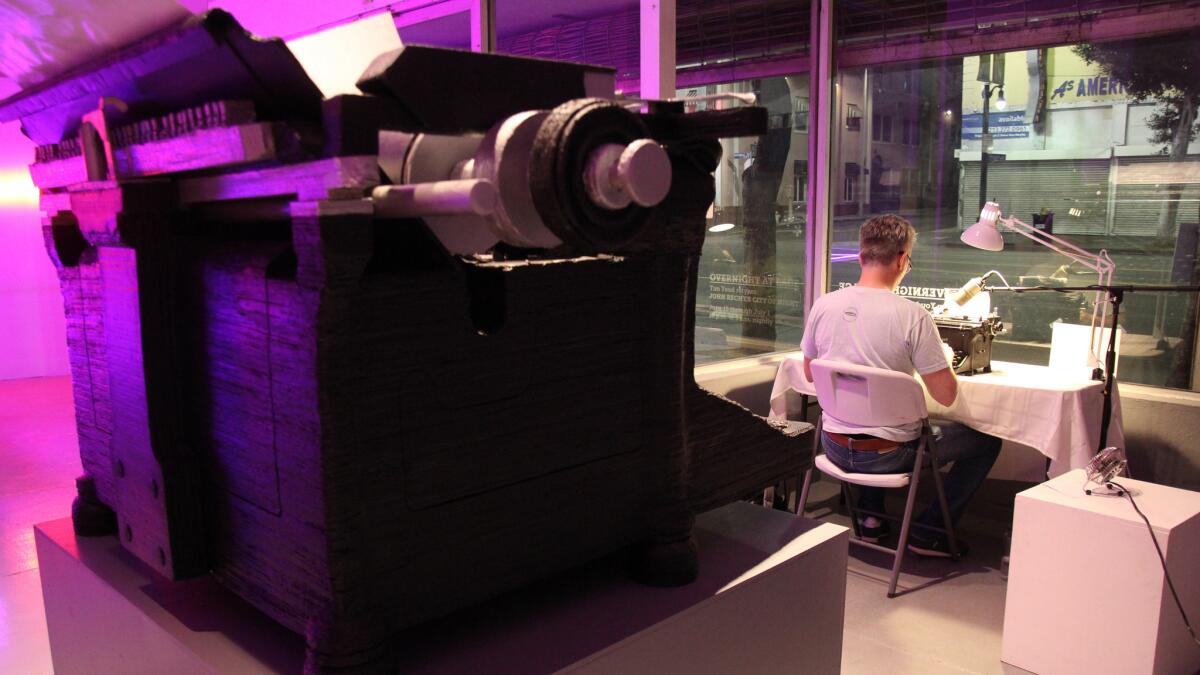
Out of all of the books that you’ve typed, which has surprised you the most?
The one that surprised me the most in the positive sense is Walker Percy’s “The Movie Goer.” It’s only a couple of hundred pages, but the feedback I’d gotten on it over time from people was, “I couldn’t finish that.” It’s a book that demands rereading. You have to bring your best to it. It does not yield easily.
He sets up a crisis and then keeps deferring the crisis. There’s a tension that dissipates and then it builds and then it dissipates. And there’s this search for something that is unidentifiable because it can’t be described. It’s a lot of work to read it. When I retyped it, I felt like I got it — and it shot right up my list of amazing novels.
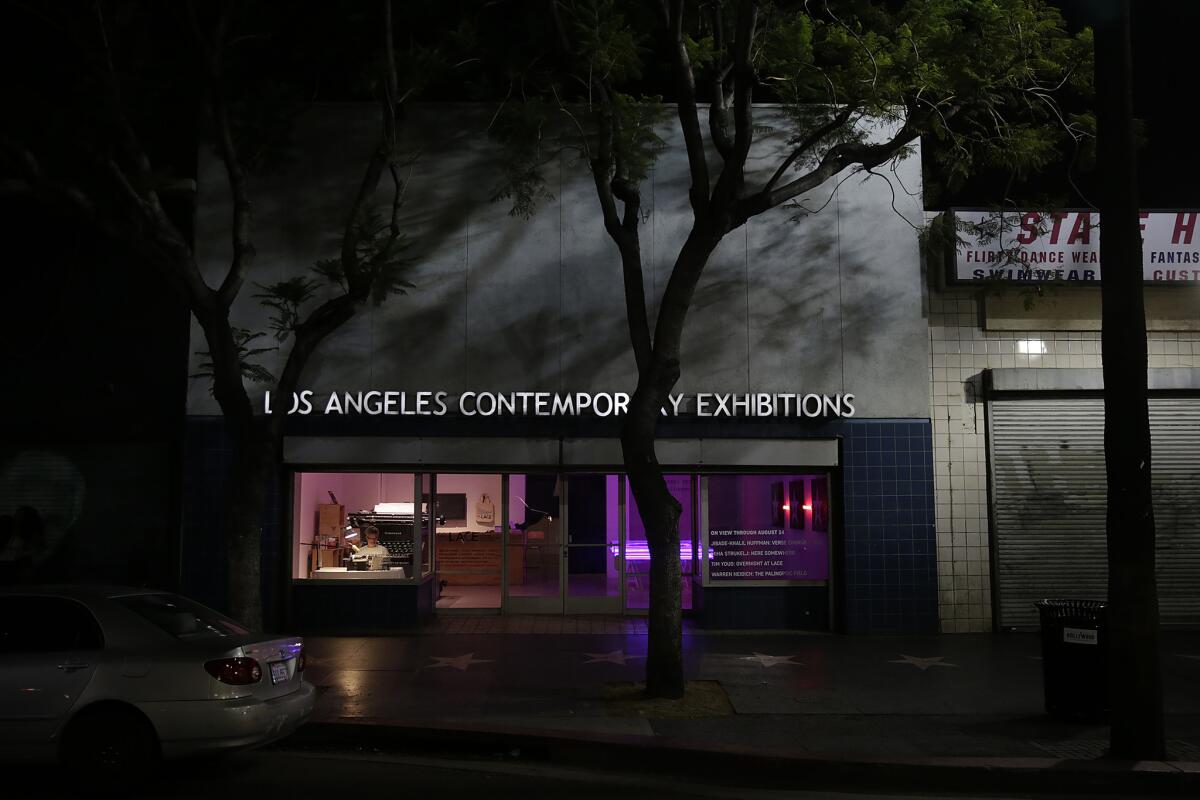
I understand Rechy came to the opening night performance at LACE. What was his reaction?
I met him about a year or so earlier through Sarah Russin. He and his partner welcomed us and they pulled out the typewriter that John used to type “City of Night.” He had it all nice and bagged up. It’s been very important to him. He gave me his blessing. I told him I wanted him to come, but he wanted to be low-key. He came like halfway through the performance. He saw the typewriter and he saw me typing and he gave me this huge grin. I think he was pleased that I had a devotion to his work and that I was doing it in a place that has memories for him.
It’s the first time I’ve typed with the author around. There aren’t too many typewriter authors left. So to have him come and celebrate it with me, it was pretty special.
Tim Youd, “100 Novels Project”
Where: Los Angeles Contemporary Exhibitions (LACE), 6522 Hollywood Blvd., Hollywood
When: Youd will retype “Numbers” at the Fern Dell Dr. entrance to Griffith Park daily starting July 6 from 11 a.m. to 4 p.m.
Info: welcometolace.org
ALSO:
John Rechy’s ‘City of Night’ turns 50
Neil Gaiman on making art, mistakes and his ‘View from the Cheap Seats’
Behind the plummeting rankings and defections of faculty and MFA students at USC’s Roski art school
Find me on Twitter @cmonstah.
UPDATES:
5:46 p.m. July 5: This article has been updated with information about Tim Youd’s move to Griffith Park to retype John Rechy’s “Numbers.”
This article was originally published at 12:58 p.m. June 30.
More to Read
The biggest entertainment stories
Get our big stories about Hollywood, film, television, music, arts, culture and more right in your inbox as soon as they publish.
You may occasionally receive promotional content from the Los Angeles Times.
